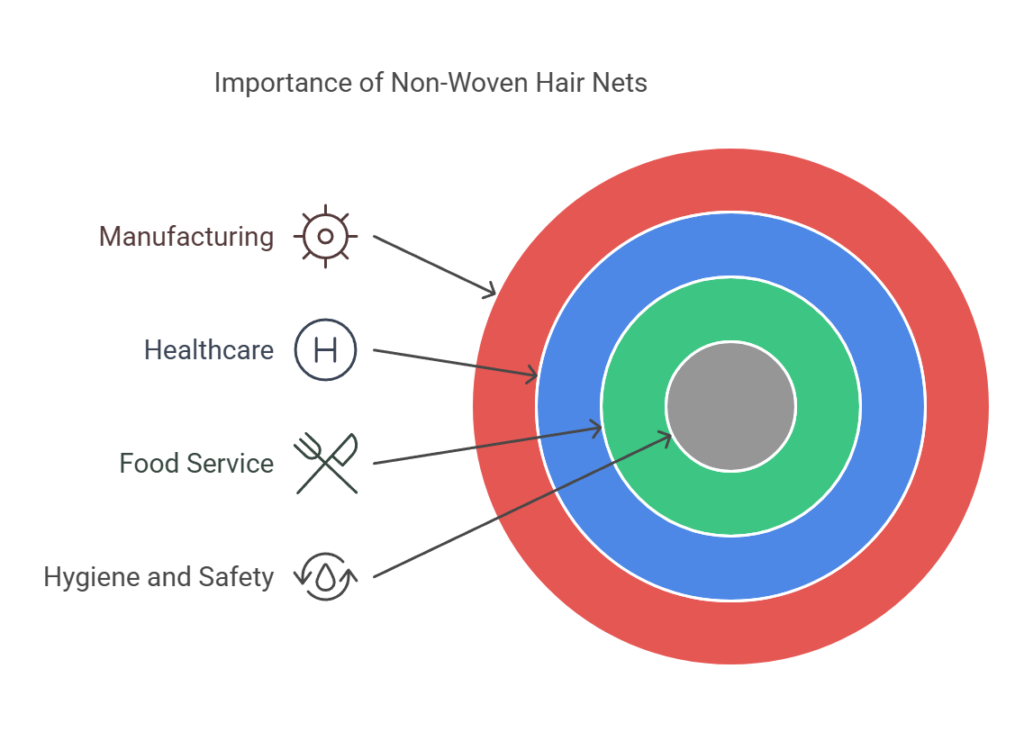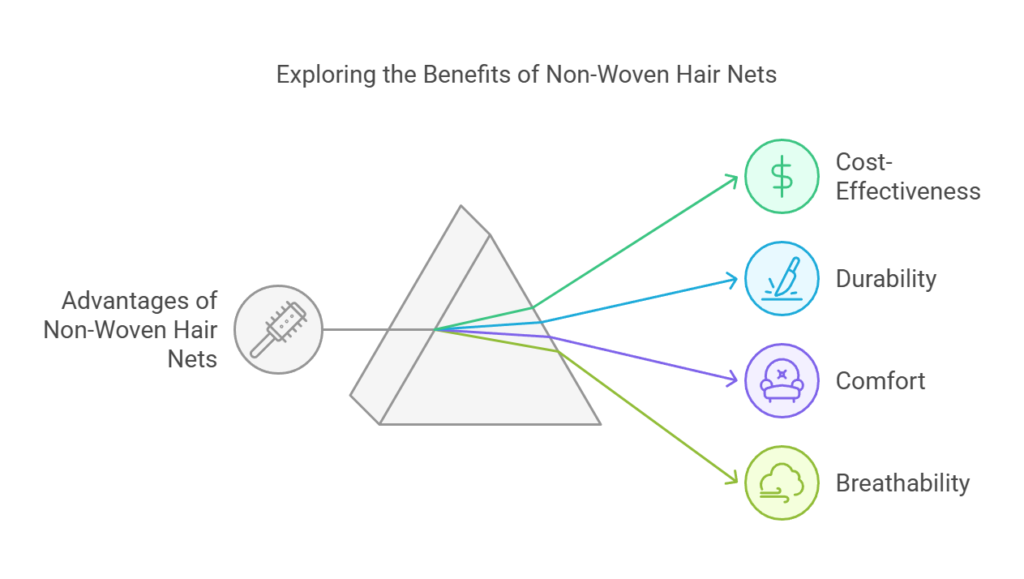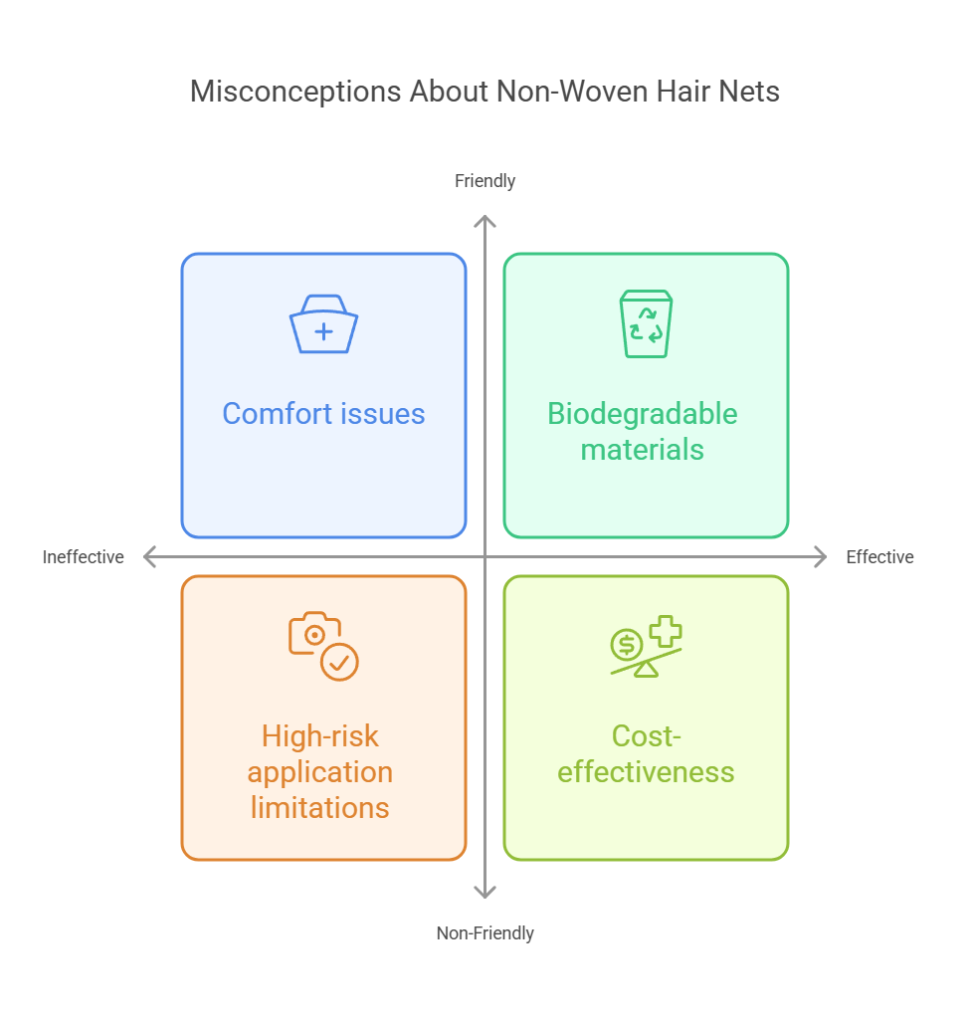Introduction: What is a Non-Woven Hair Net?
A non-woven hair net is a type of head covering designed to contain hair, ensuring it does not interfere with various professional activities. These hair nets are crafted from non-woven fabrics, which are materials made by bonding fibers together through chemical, mechanical, heat, or solvent treatment. Unlike woven fabrics, which are created through the interlacing of threads, non-woven materials are typically produced in a sheet or web structure. This manufacturing process allows non-woven hair nets to be lightweight, breathable, and cost-effective.

Non-woven hair nets are commonly made from synthetic fibers such as polypropylene, which is known for its durability and resistance to moisture. They may also incorporate other materials like nylon or polyester to enhance specific properties such as strength or elasticity. The general appearance of a non-woven hair net is often characterized by a fine mesh that ensures hair is securely contained while allowing air to circulate freely, reducing discomfort during extended wear.
The primary purpose of a non-woven hair net is to maintain hygiene and prevent hair from contaminating environments where cleanliness is paramount. This includes settings such as food processing plants, healthcare facilities, laboratories, and manufacturing units. By containing hair, non-woven hair nets help to minimize the risk of product contamination, maintain sanitary conditions, and uphold safety standards.
The key difference between woven and non-woven hair nets lies in their construction. Woven hair nets, made from interlaced threads, are typically more durable but can be less breathable and more expensive. Non-woven hair nets, in contrast, offer a balance of affordability, comfort, and practicality, making them a popular choice across various industries. Their disposable nature also adds to their convenience and effectiveness in maintaining a sterile environment.
Why is a Non-Woven Hair Net Important?
Non-woven hair nets play a crucial role in upholding hygiene and safety standards across various industries, including food service, healthcare, and manufacturing. These hair nets are designed to prevent hair and other particles from contaminating products, thus ensuring a clean and safe environment for both workers and consumers.

In the food service industry, the use of non-woven hair nets is imperative to maintain strict hygiene standards. They help prevent hair from falling into food, which can lead to contamination and potential health hazards. This is particularly important in food processing plants, restaurants, and catering services, where maintaining cleanliness is paramount to avoid foodborne illnesses. Regulatory bodies such as the Food and Drug Administration (FDA) and the Food Safety and Standards Authority of India (FSSAI) mandate the use of hair nets in these settings to ensure compliance with food safety regulations.
The healthcare sector also relies heavily on non-woven hair nets to maintain a sterile environment. These hair nets are essential for preventing the spread of infections and ensuring that medical procedures are conducted in a contamination-free setting. Surgeons, nurses, and other medical professionals typically wear hair nets in operating rooms and other sterile environments. The Centers for Disease Control and Prevention (CDC) and the World Health Organization (WHO) endorse the use of hair nets to uphold stringent infection control standards.
In the manufacturing industry, especially in cleanroom environments, non-woven hair nets are vital for controlling particulate contamination. Industries such as pharmaceuticals, electronics, and biotechnology require a high level of cleanliness to prevent defects and ensure product quality. The International Organization for Standardization (ISO) has specific guidelines for cleanroom attire, which include the use of hair nets to meet ISO 14644 standards for contamination control.
Overall, non-woven hair nets are indispensable in maintaining hygiene, preventing contamination, and ensuring safety in various professional settings. Their use is often governed by stringent regulations and standards, underscoring their importance in safeguarding public health and product integrity.
How to Properly Use a Non-Woven Hair Net
Proper usage of a non-woven hair net is crucial to maintaining hygiene and safety standards, especially in environments such as food processing, healthcare, and manufacturing. To ensure a secure fit, start by gathering all your hair at the back of your head. If you have long hair, it might be helpful to tie it into a low bun or ponytail. This step is essential to prevent any loose strands from escaping.
Next, hold the hair net with both hands and stretch it open. Place it over your head, starting from your forehead and moving it backward. Ensure that the front edge of the hair net rests just above your eyebrows, while the back edge should cover the nape of your neck. Adjust the hair net so that all your hair is fully enclosed. If the hair net has an elastic edge, make sure it sits comfortably but snugly against your scalp to prevent it from slipping.
For added comfort, choose a non-woven hair net that is breathable and lightweight. This will help in reducing any discomfort caused by prolonged usage. If you wear glasses or other headgear, ensure that the hair net does not interfere with these items. Adjust the hair net as needed to maintain a secure and comfortable fit.
Common mistakes to avoid include not fully covering all your hair, wearing the hair net too loosely, and reusing disposable hair nets. Each of these errors can compromise the effectiveness of the hair net, leading to potential hygiene and safety issues. Always follow the manufacturer’s instructions regarding the proper disposal or cleaning of the hair net to maintain its effectiveness.
In conclusion, proper usage of a non-woven hair net is vital for achieving the intended benefits of safety and hygiene. By following these steps and tips, you can ensure that the hair net serves its purpose effectively, providing you with the necessary protection in your work environment.
Advantages of Non-Woven Hair Nets over Woven Hair Nets
Non-woven hair nets offer several distinct advantages over their woven counterparts, making them increasingly popular in various industries such as food service, healthcare, and manufacturing. One of the primary benefits of non-woven hair nets is their cost-effectiveness. Due to the manufacturing process that involves bonding fibers together rather than weaving them, non-woven hair nets are generally cheaper to produce. This cost-saving aspect is particularly significant for businesses that require large quantities of hair nets on a regular basis.

Durability is another area where non-woven hair nets excel. These hair nets are designed to withstand regular use without tearing or fraying, which is a common issue with woven hair nets. The strength and resilience of non-woven materials ensure that the hair nets maintain their integrity even under demanding conditions. This durability translates to fewer replacements and a more reliable performance, ultimately contributing to overall cost savings.
Comfort is a crucial factor for anyone required to wear a hair net for extended periods. Non-woven hair nets are typically softer and more flexible than woven options, providing a more comfortable fit. The non-woven fabric conforms more easily to the contours of the head, reducing pressure points and discomfort. This enhanced comfort can lead to increased compliance among employees, ensuring that safety and hygiene standards are consistently met.
Breathability is another significant advantage of non-woven hair nets. The non-woven structure allows for better air circulation, which helps to keep the scalp cool and reduces sweating. This is particularly beneficial in hot and humid environments, where discomfort from heat can be a major issue. Improved breathability not only enhances comfort but also helps in maintaining hygiene by reducing the buildup of moisture and bacteria.
For example, in the food service industry, where maintaining hygiene is paramount, non-woven hair nets are often preferred for their superior breathability and comfort. Employees can work long shifts without the discomfort that can come from less breathable woven hair nets. Similarly, in healthcare settings, non-woven hair nets provide the necessary protection while ensuring that healthcare workers remain comfortable during extended periods of use.
Overall, the advantages of non-woven hair nets in terms of cost-effectiveness, durability, comfort, and breathability make them an ideal choice for various industries. These benefits not only improve the user experience but also contribute to better compliance with hygiene and safety standards.
Applications of Non-Woven Hair Nets
Non-woven hair nets find extensive applications across various industries, thanks to their superior hygiene and functionality. One of the primary sectors where these hair nets are indispensable is the food industry. In environments such as kitchens, food processing plants, and packaging facilities, maintaining hygiene is paramount. Non-woven hair nets help prevent hair contamination in food products, thereby ensuring compliance with stringent food safety standards and protecting consumer health.

Healthcare settings are another critical area where non-woven hair nets are widely used. Hospitals, clinics, and laboratories require a sterile environment to prevent the spread of infections. Non-woven hair nets are preferred in these settings due to their breathable material, which provides comfort during extended use, and their ability to effectively contain hair, reducing the risk of contamination. Surgeons, nurses, and other medical staff often rely on these hair nets to maintain the highest levels of cleanliness during procedures and patient care.
Cleanrooms, which are essential in industries such as pharmaceuticals, biotechnology, and electronics manufacturing, also greatly benefit from the use of non-woven hair nets. These controlled environments require minimal levels of pollutants, including hair and skin particles. Non-woven hair nets are designed to ensure that no contaminants are introduced into these sensitive areas, thus safeguarding the integrity of the products being developed or manufactured.
Additionally, non-woven hair nets are utilized in various other environments that prioritize high hygiene standards, such as spas, beauty salons, and even certain public service sectors. Their lightweight, comfortable design makes them suitable for long-term wear, while their cost-effectiveness ensures that they can be used widely without significant financial burden. The preference for non-woven hair nets across these diverse settings underscores their importance in maintaining cleanliness and preventing contamination.
Environmental Impact of Non-Woven Hair Nets
Non-woven hair nets are commonly made from synthetic materials such as polypropylene and polyester, which are known for their durability and cost-effectiveness. However, these materials present significant environmental concerns due to their non-biodegradable nature. When improperly disposed of, non-woven hair nets can contribute to the growing problem of plastic pollution, adversely affecting marine and terrestrial ecosystems.
Biodegradability is a critical factor in assessing the environmental impact of any disposable product. Unfortunately, the majority of non-woven hair nets do not decompose easily, persisting in the environment for hundreds of years. This long-term presence poses a threat to wildlife, which can ingest or become entangled in plastic debris. Efforts to mitigate this impact are crucial and have led to some promising innovations within the industry.
One such innovation is the development of biodegradable non-woven materials. These eco-friendly alternatives are made from natural fibers or plant-based polymers, which break down more readily in the environment. For instance, hair nets made from polylactic acid (PLA), a biodegradable polymer derived from renewable resources like corn starch, are gaining traction. These alternatives offer a more sustainable option without compromising the functionality of the hair nets.
Recycling presents another viable solution to reducing the environmental footprint of non-woven hair nets. While traditional recycling processes for synthetic fibers can be challenging, advancements in recycling technology are making it increasingly feasible to repurpose these materials. Some manufacturers are now implementing take-back programs, allowing consumers to return used hair nets for recycling, thus promoting a circular economy.
Overall, while the environmental impact of non-woven hair nets remains a concern, ongoing research and innovation are paving the way for more sustainable practices. By leveraging biodegradable materials and improving recycling methods, the industry can significantly diminish its ecological footprint, contributing to a more sustainable future.
Common Misconceptions About Non-Woven Hair Nets
Non-woven hair nets are often surrounded by a variety of misconceptions that can lead to misunderstanding their true value and effectiveness. One prevalent myth is that non-woven hair nets are less effective than their woven counterparts. However, this is far from the truth. Non-woven hair nets are designed to provide superior barrier properties, which can effectively contain hair and prevent contamination in sensitive environments like food processing and healthcare settings.

Another common misconception is that non-woven hair nets are uncomfortable to wear. While early versions may have had issues with comfort, modern non-woven hair nets are made with soft, breathable materials that ensure user comfort even during extended use. The lightweight nature of these hair nets helps improve breathability, reducing discomfort and making them suitable for long shifts.
Some also believe that non-woven hair nets are not environmentally friendly. In reality, many manufacturers are now producing non-woven hair nets from biodegradable materials, which significantly reduces their environmental impact. These advancements have made non-woven hair nets an eco-friendly option without compromising on their functionality and effectiveness.
There is also a misconception that non-woven hair nets cannot be used in high-risk environments. While it is true that not all non-woven hair nets are designed for high-risk applications, many high-quality options meet stringent safety standards. These hair nets are tested rigorously to ensure they provide adequate protection in various professional settings, from laboratories to food production facilities.
Lastly, some people believe that non-woven hair nets are expensive and not cost-effective for large-scale use. On the contrary, non-woven hair nets are often more affordable than their woven counterparts and are available in bulk quantities, making them a cost-effective solution for businesses.
In summary, non-woven hair nets are a reliable, comfortable, environmentally friendly, and cost-effective choice for many industries. Understanding the facts behind these common misconceptions can help in making informed decisions about their use and benefits.
Frequently Asked Questions (FAQs)
What is a non-woven hair net?
A non-woven hair net is a type of head covering made from non-woven fabric, designed to keep hair in place. It is commonly used in various industries, including food service, healthcare, and manufacturing, to maintain hygiene and safety standards.
How is a non-woven hair net different from a woven one?
Non-woven hair nets are made from synthetic fibers bonded together through chemical, mechanical, or thermal processes, creating a fabric that is durable and lightweight. In contrast, woven hair nets are made by interlacing threads. Non-woven hair nets typically offer better breathability and comfort.
When should I use a non-woven hair net?
Non-woven hair nets should be used in environments where maintaining hygiene and preventing contamination is crucial. This includes food processing areas, healthcare facilities, cleanrooms, and laboratories. They are also useful in any setting that requires hair to be securely contained.
How do I properly wear a non-woven hair net?
To wear a non-woven hair net correctly, stretch it gently over your head, ensuring that all hair is covered, including the sides and back. Adjust it to fit snugly without being too tight, ensuring it stays in place during your activity.
Can non-woven hair nets be reused?
Non-woven hair nets are typically designed for single-use to ensure maximum hygiene. However, if explicitly stated by the manufacturer, some non-woven hair nets can be reused. Always follow the manufacturer’s guidelines regarding reuse.
What is the best way to dispose of non-woven hair nets?
Non-woven hair nets should be disposed of in regular waste bins unless contaminated with hazardous materials, in which case they should be disposed of according to local regulations for hazardous waste. Consider environmentally friendly options, such as biodegradable versions, if available.
Where can I purchase non-woven hair nets?
Non-woven hair nets can be purchased from medical supply stores, industrial safety equipment suppliers, and online retailers. When purchasing, ensure you choose a reputable supplier to guarantee the quality and reliability of the product.


9 Responses
Fantastic site A lot of helpful info here Im sending it to some buddies ans additionally sharing in delicious And naturally thanks on your sweat
Real Estate I just like the helpful information you provide in your articles
Thank you for your support and recognition – it means a great deal to me. Together, let us continue on this journey of sharing knowledge and wisdom for the betterment of all.
Noodlemagazine You’re outstanding! I don’t think I’ve read anything like this before. It’s fantastic to find someone with new ideas on this subject. Really, thank you for starting this up. This website brings much-needed originality to the internet!
Thank you so much for your kind words! We’re thrilled that you appreciate the fresh perspective our content offers. Your support means a lot to us, and we’ll keep striving to bring more original and valuable content to the site.
FlixHQ I really like your method of writing blogs. I’ve added it to my bookmarks and will revisit soon
Thank you so much for your kind words! We’re thrilled that you like our blog – writing style. We look forward to your next visit. If you have any topics you’d like us to cover, feel free to let us know.
Thanks for sharing. I read many of your blog posts, cool, your blog is very good.
Thank you so much for your kind words and continuous support! We’re thrilled to hear that you enjoy our blog posts. Your feedback means a lot to us. Stay tuned for more exciting content!